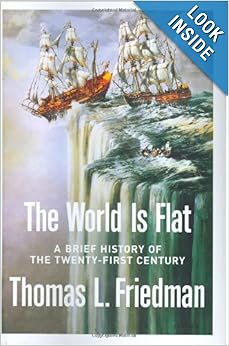 I was standing in a bookstore when I overheard a guy telling his kid a lie. "Until about a hundred years ago," he said, "everyone though the world was flat."
I was standing in a bookstore when I overheard a guy telling his kid a lie. "Until about a hundred years ago," he said, "everyone though the world was flat."Steam erupted from my ears. Did he just say that? (Making things worse is that he was pointing to a book called The World is Flat by Thomas Friedman - a book about economic globalization.) I wanted to make it a teaching moment and correct him, but he was so darned proud of himself. He seemed like a successful, smart guy, so how could he be that misinformed?
In the fourth century b.c., Aristotle explained why the earth was shaped like a sphere in a dull book called Physics. Think about how difficult that would be; without satellite photos, could you prove that the earth is not flat? Aristotle did just that with a series of scientific observations that are brilliant. He wasn't the first person to do this, but his work became the official word on the subject, and throughout the middle ages (which started many centuries later) his scientific teachings were considered unchallengeable. Later, Eratosthenes was able to determine the size of the earth with some simple geometry.
The church never wavered on this notion. Sure, there were a few detractors - just like I've had a few co-workers who thought the moon landing was fake - but the major Christian teachers consistently taught that the earth was not flat. Origen was one of the most well-known writers of the eastern church and he insisted that all of the planets were spheres. In the eighth century, English writer Bede echoed the Greek philosophers where these matters were concerned and refuted anyone who thought the planet was not spherical. Hardly any writer was as popular in the middle ages (and today) as Augustine, and he makes a reference to the earth being round in The City of God. Pope Sylvester II, (a.k.a., Gerbert of Aurillac) who was the pope in the year 1000, was a teacher of science who enjoyed painting globes and teaching students about the earth with an armillary sphere.
This is an armillary sphere. But you knew that.
The most influential book on astronomy in the middle ages was written by a guy named John of Hollywood. (Or, Johann Sacrobosco.) It boringly titled, The Tract of the Sphere. You can read the whole thing online; it's surprisingly simple and short. John of Hollywood insisted that the earth was spherical, just like every other planet, and his works were the foundation of late medieval astronomy.
Still skeptical? How about some art:
This is from Hildegard of Bingen, a 12th century nun from Germany who was probably the smartest person in Europe in her time. She taught medicine, science, and theology when she wasn't painting pictures or composing songs. In that painting, above, you can see the earth. It's round. (Look closer and you can see flames around it; in those times it was erroneously believed that flames circled the planet. Hey, no one's perfect.) One of her books attempts to describe the earth and its relationship to God (among many other things) and relies heavily on an understanding of a spherical world.
There have been other, non-western cultures that believed the Earth was flat, but European society always knew the world was round.



No comments:
Post a Comment